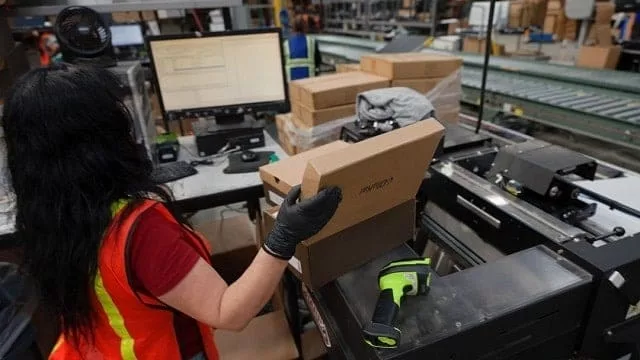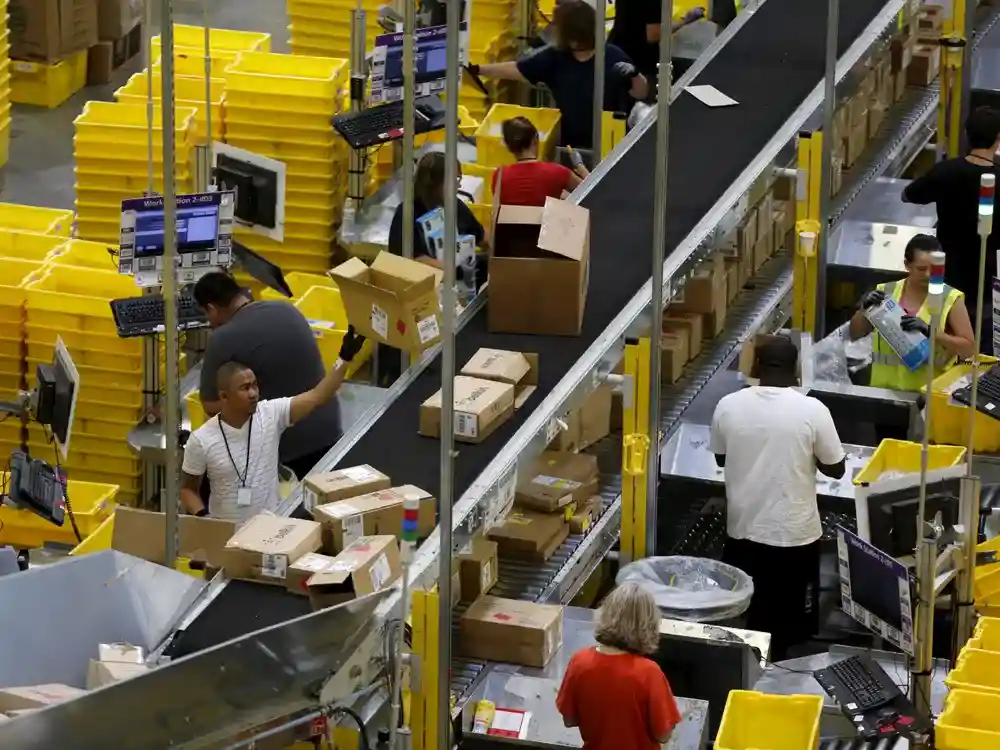Digital marketing
ECommerce warehouse: Tips, Benefits & Full Guide

E-commerce has become very popular in recent years and the market is expected to grow. According to markets and research, global eCommerce warehouse sales are expected to grow by $4 billion in the next four years.
Many business owners have converted their business into e-commerce. It is time to know how business models work and what is required. Some specific requirements to run an e-commerce business are different from other businesses. One such requirement that always does not focus on is where store e-commerce stock is and how it is managed: e-commerce warehousing and e-commerce warehouse management.
What is ecommerce warehousing?
E-commerce warehousing is the process of storing the goods that are sold on the internet. E-commerce warehouse management refers to managing all the processes that are involved in e-commerce business.
What are ecommerce warehouses?
E-commerce warehouse includes all different types of warehouses that are used to store e-commerce goods. In order to work in the proper way you need to store inventory in the e-commerce warehouse.
Private warehouses
Private warehouses are those owned by large businesses. This includes wholesalers, distributors, manufacturers, large retailers, and online marketplaces. Private warehouses are more expensive than public warehouses because it was built on user need. This includes the size of the warehouse or the way in which the warehouse has been constructed to store specific types of products. The long-term revenues that come with such a warehouse make it valued to invest in, which makes them the seamless option for e-business SMBs, private traders, and retailers.
Public warehouses
Public warehouses are owned by government agencies and rented to businesses. So their rates are under controlled by the firm. Although they are less advanced in size and functionality than private warehouses it was cheaper than others. Public warehouses are good choices for starting a new ecommerce business.
Government-owned eCommerce warehouse
Government warehouses are similar to public warehouses except they are owned by the government and work with them. Government-owned warehouses are generally provided security. So they are the best choice for storing ecommerce goods.
Smart warehouses
Smart warehouses are digital warehouses that use AI to help with their storage, fulfillment, and management requirements. In the other type of warehouse, a smart warehouse the automation is not limited to software. Drones, electric goods, robots, and carts are some kinds of technologies that you may find in a smart warehouse. These warehouses can provide more efficiency and productivity since most of the work is being done by machines. Amazon was the best example of an ecommerce business. Amazon uses digital equipment including robotic arms, mobile apps, scanning technology, conveyor belts, and picking robots to help their work smoothly.

What are ecommerce warehouse management systems and how can they help you?
An ecommerce business management system is a version of the traditional warehouse management system, but it is specially built to manage ecommerce warehouses. Here are a few fields in which ecommerce warehouse management systems can benefit more than traditional systems.
Designed for single-item orders
Traditional warehouse administration systems are used in warehouses that mainly deal with orders that cover several items. Therefore, they are planned to work with palettes, racks, and other large equipment to fulfill orders containing several products. Ecommerce business, however, primarily deals with single-item orders. According to People Vox, around 80% of orders that ecommerce businesses receive only contain one product. Therefore, ecommerce warehouses need a structure that can handle satisfying big sizes of single-item orders—this contains preparation the fastest route to each item, pick the correct item for each direction, stuffing it correctly, and delivery it to the exact address. An old system may be able to handle this, but the work may not be as effective as it could be when using a system designed for this volume of small orders.
Able to withstand demand variations
All warehouses see variations in customer demand, which is typically caused by changing trends and cyclic demands. Depending on the kind of professional, the variations could be for an exact invention or an entire category. For instance, near the end of the year, holiday-themed products are in high demand, but not so much during other parts of the year. Irrespective of what is being obtained, changes in demand are usually expected and easy to manage in traditional warehouses. Ecommerce, however, involves the same variations as outdated warehouses but requests increases and reductions by a larger ratio. To cope with this, you need a system to handle all the orders you receive as well as a waiter that can handle the traffic of all the customers using your website. An ecommerce WMS can deliver both of these structures.
Accurate inventory management
Having a correct count of your record is vital for any kind of warehouse, but it is especially significant for Ecommerce business. This is because these routine numbers are always directly reflected on your ecommerce website for your clients to see. Not expressive that you have in your routine and displaying incorrect quantities can leave a bad impression, hurt your sales, and make orders time-consuming to sort out. With accurate inventory management, you can display how many products you have left in routine (like Amazon does), giving customers motivation to buy from you before stock runs out. An ecommerce WMS can help you keep track of all of your external and outgoing inventory. And integrate with your ecommerce platform so that everything is synchronized and running easily.
Handling more returns
A typical return process in ecommerce starts when the buyer recruits the return, after which the business makes a return label, gathers the returned item, updates their record and the order position, and finally informs the client of the return position and repayment or replaced product. Each of these processes needs to be performed in this order, on time, and correctly for the return to be fully processed—an error in even one of these processes confusions up the flow for the rest.
3 benefits of using an outdoor eCommerce warehouse
Using an external eCommerce warehouse to supply your inventory can be extremely helpful. Joining with a well-known 3PL like Ship Bob provides ecommerce retailers access to an amount of external e-commerce business to select from. These state-of-the-art nirvana centers can be used to cut shipping costs and speed up delivery times (e.g., 2-day shipping).
Here are a few details why ecommerce warehousing is frequently top left to the experts.

1. Easier to stay organized
With more space and a better structural system, you’ll have an easier time handling everything from inventory chasing to customer orders. A 3PL provider can take the boring inventory management process off your hands and save tags on your products for you.
Moreover, Ship Bob’s branded contentment package keeps ecommerce business’s products up to date with real-time inventory amounts, delivery tracking, and much more.
“Ship Bob’s skill provides cost funds. Other 3PLs pass fees onto the client for work they do tell to manual courses because they lack the fulfillment skills needed to meet client expectations. Ship Bob’s knowledge has well removed the work of a package manager at other 3PLs, while only if immediate discernibility into a list and the ability to reply and make variations myself.”
2. More accurate picking and padding
In addition to ecommerce businesses 3PL services include warehouse picking and packing, taking much of the self-actualization process off your plate. They have highly specialized staff for each part of the order contentment process and others that work to classify supply chain optimizations. Their technology and processes help ensure the right crops are packaged and delivered on time for a good customer experience.
“If I’m employed to commission one of the most significant parts of my gainful, it needs to be in the digits of people who are truthful, familiar, and can do the job a lot better than me. Ship Bob was the seamless fit.”
3. Time to focus on growth
Successfully growing your business demands a significant amount of time, attention, and resources. By using a 3PL provider, you won’t get bogged down in the components of ecommerce warehousing. Instead, you can allocate your time and staff to other functions like expanding your customer base. Your e-commerce warehouse can smoothly help provide progress.
“We are growing certainly fast and won’t slow down anytime soon. With Ship Bob, we have the option to use more of their e-commerce warehouses to decrease shipping costs. Because Ship Bob has a lot of people to grip our instructions and extra warehouses we can enlarge into. We can scale up with ease as we last to grow quickly. If we completed our own eCommerce warehouse, it would be much firmer to hire people. And we’d unavoidably enlarge the space.”
3 Essential Steps to Setting Up Your eCommerce warehouse
Determine the warehouse space needed
Good warehouse development starts with the simple query: “How much warehouse space do I need?” A good opening point is to calculate how many palettes and boxes you plan on booming at any one point. And then increase that number by the footmark of your average pallet or box.
It’s okay if this number far exceeds your total warehouse footmark. Remember, your storage space should be intended in terms of cubic feet of space. Because you will likely be using storage and canceling systems to get the most out of your total space. Too often warehouses calculate only the storage space that they need, without sufficiently taking into account other warehouse operations.
Once you calculate the warehouse area you need, consider that you will need to have acceptable space for each of these stages:
- · Receiving (including unloading, rate control reviews, and labeling sites)
- · Storage
- · Growth
- · Forward performance (incorporate space for at least one day’s worth of orders)
- · Shipping value control
- · Palette breakdown areas
- · Extra area for revenues and “dead” stock
Depending on size, extra areas for whole performance, value-added processes, and so on
Determine your essential equipment
Warehouse equipment is essential—or not—depending on your goods, your volume, and your business model. That said, most eCommerce warehouses and Nirvana centers have the same basic goals: maximize space, increase efficiency in the flow of goods, recover visibility, and do it all in a way that’s secure for someone’s and for your interests.
This teaches us to four basic kinds of warehouse tools, based on warehouse procedures:
- Storage equipment: Storage equipment includes everything from large warehouse cancels and brackets to small baskets and drawers.
- Material Management Equipment: Material handling equipment is a broad category that includes transport tackle, unit load equipment, storage equipment, and location equipment.
- Packing and Delivery Equipment: This includes anything needed to collect, package, and label orders to make them for shipping.
- Barcoding Equipment/Inventory Management Software: In today’s modern warehouse, these pieces of tackle deserve a category of their own. Barcoding gear includes barcode readers, naturally, as well as printers, labels, and associated eCommerce software.
List the tools you anticipate requiring in each category. Then, add to your design where these bits of kit will be placed, used, and/or held.
Find ways to automate repetitive processes
Automation is a reliable way to improve efficiency. ECommerce has already made the browsing and buying process much more effective through robotics. Why not do the exact for your warehouse when offshoots are processed and dispatched?
Automation doesn’t have to be a complete difference to your warehouse. In fact, the best automation centers around small buys in single-task devices. Take the following as examples:
- Bar-code digital scanners can help update picking and eliminate cycle counts while cultivating accuracy.
- A transporter belt can safely move heavy containers from one area to another, removing the need to carry standard and thus putting less strain on staff.
- An optical maser DIM-weight scanner can automatically calculate the sizes of batches to ensure accuracy and speed up the shipping process.
- Machines for ordinary, boring tasks—for example, breaking down palettes or boxes—can save time and prevent boring stress for your employees.
Digital marketing
Digital Marketing Essentials Stukent ISBN: Your Ultimate Guide

It is essential for firms to become experts in online marketing in order to succeed in this digital era. No marketer, no matter how experienced, can afford to ignore the importance of knowing the digital marketing essentials digital marketing essentials stukent isbn. If you want to discover how to use digital marketing to your advantage, this is the book for you.
Digital Marketing Fundamentals
Digital marketing essentials stukent isbn is an umbrella term for a variety of online marketing approaches with the common goal of attracting and retaining customers. To thrive in the digital world, you must grasp the basics, whether it’s search engine optimization (SEO), social media marketing, email campaigns, or anything else.
Exploring Stukent ISBN: The Ultimate Resource
Digital marketing essentials stukent isbn serves as an example of excellence in digital marketing education for its breadth and depth of knowledge. Marketers may use their resources to stay ahead of the curve in an ever-changing industry. They offer practical tools, real-world applications, and vital insights.
Understanding SEO Basics
Search engine optimization is fundamental to any effective online advertising campaign. You can boost your online visibility, attract more organic visitors, and increase sales by optimizing the content and structure of your website for search engines. You can’t succeed in search engine optimization (SEO) without first learning the basics, which include keyword research, on-page optimization, and link building.
Crafting Compelling Content
In the world of digital marketing, content is still king and the bedrock of every effective campaign. Capturing your audience’s attention, establishing trust, and driving conversions are all possible through the creation of high-quality, engaging content that is customized to their requirements and interests.
Harnessing the Power of Social Media
Unlike any other marketing channel, social media allows companies to instantly interact with their target demographic, raise product awareness, and cultivate genuine connections. Being able to make the most of every platform—Facebook, Instagram, Twitter, and LinkedIn—is crucial for thriving in today’s digital world.
Email Marketing Mastery
One of the internet marketer’s most potent weapons is email marketing. You can cultivate leads, boost sales, and establish enduring connections with your audience by creating engaging email campaigns that provide subscribers with value.
Analytics and Measurement
To be truly effective, digital marketing campaigns must be continuously monitored, analyzed, and optimized—not to mention launched. Gaining insights into your audience’s behavior, tracking the performance of your campaigns. And making data-driven decisions are all made possible using analytics tools and metrics.
Staying Ahead of the Curve
New strategies, tactics, and technology are appearing all the time in the ever-changing world of digital marketing. You can set yourself and your company up for success in a dynamic climate by being well-informed, flexible, and proactive.
Conclusion
Mastering the digital marketing essentials Stukent ISBN to thrive in the modern business environment. You can set yourself and your company up for sustained success in the digital sphere by mastering the basics, making good use of available tools, and anticipating and avoiding trends.
FAQ’s (Frequently Asked Questions)
Q: What is digital marketing essentials stukent isbn?
digital marketing essentials stukent isbn is an industry-leading resource for digital marketing education. Providing students and professionals with in-depth courses, simulations, and tools to become experts in the field.
Q: How can I access digital marketing essentials stukent isbn resources?
Through its website or through collaborating educational institutions, digital marketing essentials stukent isbn provides a variety of resources, such as online courses, simulations, textbooks, and more.
Q: What topics does Stukent cover?
Search engine optimization (SEO), social media marketing (SMM), content marketing (CM), email marketing (EM), analytics (AI). And many more topics are covered by digital marketing essentials stukent isbn.
Q: Are Stukent’s resources suitable for beginners?
Any level of learner, from complete novices to seasoned pros. Will find something useful in digital marketing essential’s stukent isbn offerings. Their training and resources provide an all-inclusive overview of digital marketing basics, and anyone may take use of them.
Q: How can I incorporate Stukent’s resources into my digital marketing strategy?
Incorporate digital marketing essential’s stukent isbn courses, tools. And simulations into your digital marketing plan to remain ahead of the curve in an ever-evolving sector. Obtain important insights, and polish your abilities.
Q: Is Stukent’s content up-to-date with the latest industry trends?
Digital marketing essential’s stukent isbn will, in fact, make every effort to keep up with the most recent developments in digital marketing. To make sure that students get the most relevant and current information. Their materials are updated on a regular basis to reflect the latest advances.
Digital marketing
Unleash Your Business Potential with Digi10x Online Digital Marketing Agency

A good online presence is essential for any organization to succeed in the modern digital era. Working with a reputable digital marketing agency that can guide you through the complexity and make you stand out from the competition is crucial given the fierce competition in the digital space. Now present to you, your one-stop shop for all things digital marketing: Digi10x Online Digital Marketing Agency.
Why Choose Digi10x Online Digital Marketing Agency?
In the vast ocean of digital marketing agencies, Digi10x stands out as a beacon of excellence. Here’s why:
1. Tailored Strategies for Maximum Impact
At Digi10x, we are aware that there is no one-size-fits-all approach to digital marketing. For this reason, we develop specialized plans based on your particular company objectives and target market. We can help you achieve your goals of increasing website traffic, improving your online presence, or producing more leads.
2. Cutting-edge Technology and Tools
We use the newest tools and technology because we think it’s important to stay ahead of the curve and to help our clients achieve their goals. We harness the power of innovation to produce quantifiable ROI and stay ahead of the competition, using everything from AI-powered insights to advanced analytics.
3. Expert Team of Digital Marketing Professionals
Our team of seasoned specialists in digital marketing is committed to assisting companies in thriving in the digital sphere. They are prepared to take on any task and produce outstanding outcomes since they have years of industry expertise and a thorough awareness of the most recent trends and best practices.
4. Comprehensive Range of Services
We provide an extensive range of services to fulfill all of your digital marketing requirements under one roof, from search engine optimization (SEO) and pay-per-click (PPC) advertising to social media marketing and content production. We offer the knowledge and resources to support your growth, regardless of your company’s size—from startups to Fortune 500 brands.
5. Proven Track Record of Success
Don’t only believe what we say. Our past performance is quite evident. We have assisted numerous companies from a variety of industries over the years in achieving their digital marketing objectives and producing noticeable outcomes.
6. Transparent Communication and Reporting
That’s why we offer comprehensive information on the effectiveness of your campaigns and keep you updated at every stage. You’ll always be aware of where your marketing budget is going and how it affects your bottom line when you work with us.
Conclusion:
In conclusion, Digi10x Online Digital Marketing Agency is the reliable partner you can rely on to help your company reach its full potential online. We offer everything you need to succeed, including specialized tactics, state-of-the-art technology, a knowledgeable staff, extensive services, a track record of success, and open and honest communication. Why then wait? Use Digi10x to grow your company to new heights right now!
FAQ’s (Frequently Asked Questions)
Q: What sets Digi10x apart from other digital marketing agencies?
Digi10x online digital marketing agency distinguishes itself with customized tactics, state-of-the-art equipment, a knowledgeable staff, all-inclusive offerings, a demonstrated track record, and open lines of contact.
Q: How long does it take to see results with Digi10x?
The complexity of your objectives, the level of industry competition, and the success of the tactics you employ will all have an impact on how quickly you get results. Delivering quantifiable outcomes as quickly as feasible is our constant objective, nevertheless.
Q: Is Digi10x suitable for small businesses?
Without a doubt! Digi10x online digital marketing agency serves companies of various kinds, from small startups to major multinational corporations. We customize our services to meet your needs and budget since we think every company should have the opportunity to thrive in the digital sphere.
Q: Does Digi10x offer ongoing support and maintenance?
Sure, we are committed to creating enduring relationships with our clients. We offer continuing assistance, monitoring, and optimization to make sure your campaigns keep performing at their peak. And adjust to changes in the digital landscape after the initial setup and deployment.
Q: How can I get started with Digi10x?
Digi10x online digital marketing agency is simple to use and get started with. One of our digital marketing specialists would be pleased to talk with you about your goals and suggest the best course of action to help you attain them. All you have to do is contact us via our website or by phone.
Q: Can I track the performance of my campaigns with Digi10x?
Of course! We give you access to thorough data and analytics so you can monitor the effectiveness of your ads in real time. All the information you require to make wise choices and maximize your marketing endeavors will be at your fingertips. Ranging from website traffic and conversion rates to ROI and beyond.
Digital marketing
Unlocking the Power of Connectivity: Important Benefits of Getting Remote IT Support

In the ever-evolving landscape of technology, businesses and individuals alike are becoming increasingly reliant on Information Technology (IT) to streamline operations, enhance productivity, and stay competitive in the market. With the rise of remote work, the demand for efficient IT support has skyrocketed. Remote IT support, a service that allows professionals to troubleshoot and resolve IT issues without being physically present, has emerged as a crucial component for businesses and individuals seeking seamless and uninterrupted IT services. If you experience any problems with your system, contact the remote IT Support Denver team.
This blog explores the significant benefits of embracing remote IT support, shedding light on how this innovative approach can revolutionize the way organizations and individuals address and resolve IT challenges.
Instant Issue Resolution
One of remote IT support’s standout advantages is promptly addressing issues. Unlike traditional IT support, which often requires technicians to be physically present at the location, remote support allows for real-time access to systems and networks. This translates to quicker identification and resolution of problems, minimizing downtime and maximizing productivity.
Remote IT support leverages advanced technologies to establish secure connections with users’ devices, enabling IT professionals to diagnose and fix issues in a matter of minutes. This instant problem-solving capability is invaluable for businesses where time is of the essence, ensuring that operations remain uninterrupted.
Cost-Efficiency
Traditional on-site IT support can be expensive, especially for small and medium-sized enterprises (SMEs) with limited budgets. Remote IT support offers a cost-effective alternative by eliminating the need for travel expenses and reducing downtime. Businesses can save significantly on overhead costs associated with maintaining an on-site IT team or outsourcing on-site support.
Additionally, remote IT support often operates on a subscription or pay-as-you-go model, allowing organizations to scale their IT support services based on their needs. This flexibility ensures that businesses only pay for the services they use, optimizing cost-efficiency without compromising on the quality of support.
Global Reach and 24/7 Availability
In a globalized world where businesses operate across different time zones, the concept of a 9-to-5 workday is becoming obsolete. Remote IT support recognizes this shift by offering 24/7 availability, ensuring that assistance is accessible whenever and wherever it is needed.
The global reach of remote IT support enables organizations to collaborate with professionals from around the world, tapping into a diverse pool of expertise. This is particularly beneficial for businesses that operate internationally, as they can receive support tailored to specific regional requirements.
Enhanced Security Measures
Security is a paramount concern in the digital age, and remote IT support has stepped up to address these challenges. Contrary to common misconceptions, remote IT support services employ robust security measures to safeguard sensitive data and ensure compliance with privacy regulations.
Modern remote IT support solutions utilize encryption technologies and secure protocols to establish a protected connection between the user’s device and the support professional. This ensures that sensitive information remains confidential throughout the troubleshooting process. Additionally, remote IT support providers often implement multi-factor authentication and other security best practices to fortify the protection of systems and data.
Proactive Monitoring and Maintenance
Remote IT support extends beyond reactive issue resolution; it embraces a proactive approach to prevent problems before they impact operations. Through remote monitoring tools, keep a vigilant eye on the health and performance of systems, identifying potential issues and vulnerabilities in real-time.
Proactive maintenance allows for promptly implementing updates, patches, and security measures, reducing the risk of cyber threats and system failures. This anticipatory approach to IT support contributes to a more stable and secure IT environment, minimizing disruptions and ensuring a seamless user experience.
Scalability and Flexibility
Businesses are dynamic entities that experience fluctuations in their IT support requirements. Remote IT support offers scalability and flexibility, adapting to the evolving needs of organizations. Whether a business is expanding its operations, implementing new technologies, or facing temporary spikes in support requests, remote IT support can scale up or down accordingly.
This scalability ensures that businesses do not find themselves overburdened with unnecessary support resources during quiet periods or scrambling to meet demand during peak times. The flexibility of remote IT support aligns with the agile nature of modern businesses, allowing them to respond swiftly to changing circumstances.
Employee Productivity and Satisfaction
Remote IT support contributes significantly to employee productivity and satisfaction by minimizing disruptions and providing swift solutions to technical challenges. When employees encounter IT issues, having access to remote support means they can quickly get back to work without waiting for on-site assistance.
The convenience of remote IT support also resonates with remote and distributed teams, offering the same level of service to employees working from various locations. This inclusivity enhances overall job satisfaction and contributes to a positive work environment.
Environmental Impact
The environmental benefits of remote IT support should not be overlooked. By reducing the need for travel associated with on-site support, businesses can contribute to lowering their carbon footprint. Remote support aligns with sustainable practices, as it minimizes the use of transportation and associated emissions.
Moreover, implementing remote IT support can reduce the need for physical infrastructure, such as office space and utilities, further contributing to environmental conservation. Embracing remote IT support is a strategic business decision and a step towards promoting eco-friendly practices.
Access to Specialized Expertise
Remote IT support opens the door to a vast pool of specialized expertise. Regardless of size or industry, businesses can access professionals with diverse skill sets and experience. This is particularly beneficial for niche industries or organizations with unique IT requirements that a local on-site team may not adequately address.
The ability to tap into a global network of IT professionals ensures that businesses receive the best possible support tailored to their specific needs. This democratization of expertise levels the playing field, allowing smaller enterprises to benefit from the same high-quality IT support as their larger counterparts.
Adaptability to Evolving Technologies
In the rapidly evolving landscape of technology, staying ahead of the curve is essential for businesses to remain competitive. Remote IT support providers are well-positioned to adapt to emerging technologies and stay current with industry trends. This ensures that businesses receiving remote support can leverage the latest innovations without the burden of constantly updating their in-house IT teams.
The adaptability of remote IT support is particularly valuable for businesses in industries such as fintech, healthcare, and e-commerce, where staying abreast of technological advancements is critical for success. Organizations can future-proof their IT infrastructure by partnering with remote IT support providers and maintaining a competitive edge.
Conclusion
The benefits of getting remote IT support are undeniably transformative, offering businesses and individuals a streamlined, efficient, and cost-effective solution to address the complexities of the digital age. From instant issue resolution and cost-efficiency to global reach and 24/7 availability, remote IT support has become a cornerstone for success in the modern business landscape.
As organizations continue to navigate the challenges and opportunities presented by technology, embracing remote IT support is not just a strategic choice but a necessity. The ability to harness the power of connectivity, access specialized expertise, and proactively manage IT infrastructure positions businesses on the path to sustained growth and resilience in an ever-evolving digital world.
%27%20fill-opacity%3D%27.5%27%3E%3Cellipse%20fill%3D%22%23ffffe7%22%20fill-opacity%3D%22.5%22%20rx%3D%221%22%20ry%3D%221%22%20transform%3D%22matrix(119.96767%203.25052%20-1.77656%2065.56788%20296.4%20185.5)%22%2F%3E%3Cellipse%20fill%3D%22%2300003e%22%20fill-opacity%3D%22.5%22%20rx%3D%221%22%20ry%3D%221%22%20transform%3D%22matrix(8.269%20-63.73005%20183.28345%2023.78111%20278.5%2014.9)%22%2F%3E%3Cellipse%20fill%3D%22%2300003d%22%20fill-opacity%3D%22.5%22%20rx%3D%221%22%20ry%3D%221%22%20transform%3D%22matrix(29.2198%20-54.72382%20105.01907%2056.07496%2017%20155)%22%2F%3E%3Cellipse%20fill%3D%22%239d9f89%22%20fill-opacity%3D%22.5%22%20rx%3D%221%22%20ry%3D%221%22%20transform%3D%22matrix(49.74092%2048.70991%20-22.5593%2023.0368%20164.7%20131.7)%22%2F%3E%3C%2Fg%3E%3C%2Fsvg%3E)
 Blogging Knowledge11 months ago
Blogging Knowledge11 months agoWorkforce software eleveo

 Digital marketing8 months ago
Digital marketing8 months agoStreamlining Financial Success: The Comprehensive Benefits of Choosing Hiveage for Invoicing

 Tech Information4 months ago
Tech Information4 months agoGet Ready to be Blown Away – A Review of the Geekzilla.tech Honor Magic 5 Pro
%22%20transform%3D%22translate(.8%20.8)%20scale(1.5625)%22%20fill-opacity%3D%22.5%22%3E%3Cellipse%20fill%3D%22%23fff%22%20rx%3D%221%22%20ry%3D%221%22%20transform%3D%22matrix(-208.42007%20-146.922%2023.26315%20-33.00056%20204%2012.4)%22%2F%3E%3Cellipse%20fill%3D%22%23d7d7d7%22%20cx%3D%2246%22%20cy%3D%2243%22%20rx%3D%22169%22%20ry%3D%2233%22%2F%3E%3Cellipse%20fill%3D%22%23fff%22%20rx%3D%221%22%20ry%3D%221%22%20transform%3D%22rotate(6.8%20-310.9%201988.7)%20scale(27.08468%20173.29944)%22%2F%3E%3Cpath%20fill%3D%22%23fff%22%20d%3D%22M123-16l7%2036%20130-7z%22%2F%3E%3C%2Fg%3E%3C%2Fsvg%3E)
 Blogging Knowledge4 months ago
Blogging Knowledge4 months agoUnderstanding TER Reviews: A Comprehensive Guide

 online earning10 months ago
online earning10 months agoFree Government iPhone(2023): How to Get & Where
%22%20transform%3D%22translate(.5%20.5)%22%20fill-opacity%3D%22.5%22%3E%3Cellipse%20fill%3D%22%23c7cee9%22%20rx%3D%221%22%20ry%3D%221%22%20transform%3D%22matrix(-103.0942%2026.2137%20-13.47071%20-52.97812%2061.5%20168.5)%22%2F%3E%3Cellipse%20fill%3D%22%233f4600%22%20cx%3D%2216%22%20cy%3D%2245%22%20rx%3D%22191%22%20ry%3D%2253%22%2F%3E%3Cellipse%20fill%3D%22%23c47a35%22%20cx%3D%22178%22%20cy%3D%22190%22%20rx%3D%2227%22%20ry%3D%22120%22%2F%3E%3Cellipse%20fill%3D%22%23d8695d%22%20rx%3D%221%22%20ry%3D%221%22%20transform%3D%22matrix(-28.6723%20-.65067%20.55819%20-24.59717%2077.3%2080.9)%22%2F%3E%3C%2Fg%3E%3C%2Fsvg%3E)
 Blogging Knowledge6 months ago
Blogging Knowledge6 months agoWhen Nature Strikes: The Unforgettable Day Bird Just Shat On My Sisters Face

 Digital marketing10 months ago
Digital marketing10 months agoBest Digital Marketing Agency Primelis

 tech10 months ago
tech10 months agoTop High DA Profile Creation Sites List 2023




















